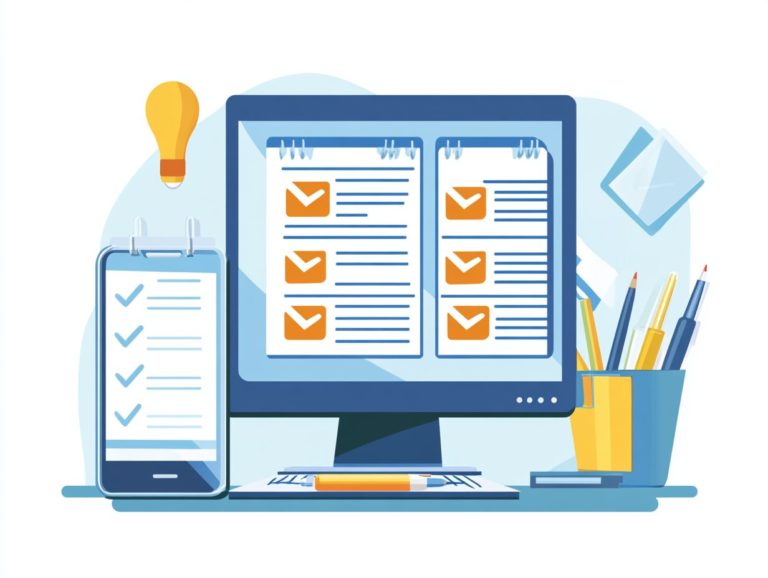“7 Common To-Do List Mistakes to Avoid”
In your fast-paced life, to-do lists can be an invaluable ally, helping you stay organized and focused.
However, many individuals inadvertently undermine their productivity by falling into common traps when using these lists. Whether it’s neglecting to prioritize tasks or setting unrealistic goals, these missteps can lead to frustration and overwhelm.
This article delves into seven frequent pitfalls in to-do list management and provides practical tips for crafting effective lists that enhance both personal and professional productivity.
Get ready to supercharge your task management skills now!
Contents
- Key Takeaways:
- 1. Not Prioritizing Tasks
- 2. Setting Unrealistic Goals
- 3. Not Breaking Down Large Tasks
- 4. Not Setting Deadlines
- 5. Not Revisiting and Updating the List
- 6. Not Celebrating Completed Tasks
- 7. Not Being Specific with Tasks
- How Can a To-Do List Help with Productivity?
- How Can a To-Do List Be Used for Personal and Professional Life?
- What Are Some Alternative Methods for Organizing Tasks?
- Frequently Asked Questions
- What are the 7 common to-do list mistakes to avoid?
- Why is it important to prioritize tasks on a to-do list?
- How can setting realistic goals help in managing a to-do list?
- Why should big tasks be broken down on a to-do list?
- What is the importance of including deadlines on a to-do list?
- How often should a to-do list be reviewed and updated?
- Why is it important to categorize tasks properly on a to-do list?
Key Takeaways:

- Not prioritizing tasks can lead to procrastination and important tasks may be overlooked.
- Setting unrealistic goals on your to-do list can lead to feelings of failure and frustration.
- Breaking down large tasks into smaller, manageable ones makes them easier to tackle and can boost motivation.
1. Not Prioritizing Tasks
Not prioritizing tasks is one of the most prevalent missteps you might encounter while managing your to-do list, often leading to confusion and a dip in efficiency. Prioritization is essential; it ensures that the critical tasks are tackled first.
This allows you to focus on what truly matters and align your daily activities with your broader goals. By implementing strategies like the Eisenhower Matrix a simple tool that helps you decide what tasks are urgent and important you can effortlessly categorize tasks based on their urgency and importance.
This framework not only highlights what demands your immediate attention but also encourages you to delegate or postpone less critical activities.
Maintaining a balanced approach to mixed goals enhances your overall productivity while fostering a rewarding sense of achievement. On the flip side, neglecting task prioritization can lead to overwhelm, making it challenging to meet deadlines and potentially pushing you towards burnout.
Recognizing and addressing your priorities is, therefore, essential for achieving sustained task efficiency and effective action.
2. Setting Unrealistic Goals
Setting unrealistic goals can quickly hurt your productivity and motivation. By establishing achievable and manageable tasks tailored to your capabilities and available time, you can build a good work habit and build momentum toward reaching your personal goals.
Recognizing the limitations of your time and resources is crucial. For example, employing effective time estimation techniques like the Pomodoro Technique or time-blocking enables you to allocate specific periods for focused work.
This ensures that you tackle each task without the pressure of looming deadlines. Planning ahead is also essential; a well-structured to-do list helps prioritize your tasks and break them down into smaller, actionable steps.
A balanced schedule helps you make progress and mitigates feelings of overwhelm. It ultimately leads to a greater sense of satisfaction in your accomplishments. Start small, and watch your productivity soar!
3. Not Breaking Down Large Tasks
Not breaking down large tasks into smaller, manageable pieces can lead you straight into the traps of procrastination and overwhelm. By defining clear actions for each component of a significant project, you can steadily move toward task completion while enjoying a consistent workflow.
This approach not only clarifies the stages of your project but also simplifies the entire process. Transforming what might seem like an insurmountable challenge into a series of achievable goals is key.
To kick things off, identify your primary objective and then list all the steps required to reach it. Organizing those tasks by priority or deadlines ensures a logical progression.
As you focus on completing these smaller tasks, you ll likely notice a boost in morale and motivation, as each small victory becomes a reason to celebrate. This psychological advantage can effectively counter feelings of overwhelm, allowing you to sustain productivity over time with ease.
4. Not Setting Deadlines
Failing to set deadlines for your tasks can dampen your sense of urgency and impede your ability to manage time effectively, often resulting in delays in completing tasks and a growing sense of frustration.
By establishing clear deadlines, you create urgency that drives consistent productivity and enables you to track your progress toward achieving your goals.
The right deadlines can transform daunting projects into manageable milestones, simplifying your focus and enhancing your motivation.
You can elevate your productivity by employing strategies such as the SMART criteria, a method that helps you set clear and realistic deadlines ensuring your deadlines are Specific, Measurable, Achievable, Relevant, and Time-bound.
Breaking larger tasks down into smaller, timed segments not only fosters a sense of accomplishment but also keeps accountability front and center. When you commit to a timeframe, you re more likely to prioritize your responsibilities, ultimately nurturing discipline and using a proactive approach to task management.
5. Not Revisiting and Updating the List

If you don t update your to-do list often, you risk becoming disorganized and lack clarity regarding your goals, ultimately diminishing your overall productivity.
This practice also offers a clearer view of what needs to be accomplished and cultivates a sense of achievement as you cross off completed tasks.
Productivity experts suggest dedicating specific time each week to review and refine your list, making sure it reflects any shifts in deadlines or new responsibilities.
Breaking larger tasks into smaller, manageable steps can help you maintain momentum. By actively assessing the urgency and importance of each item, you can prioritize efficiently, leading to better time management and a notable reduction in stress.
6. Not Celebrating Completed Tasks
Failing to celebrate your completed tasks can seriously undermine your motivation and drive, making it challenging to maintain a productive work ethic over time.
Recognizing and rewarding your accomplishments, no matter how small, cultivates a positive mindset and encourages you to keep progressing in your tasks.
This positive reinforcement serves as a boost to your mood and motivation, enhancing your sense of competence and satisfaction.
Incorporating mental breaks and personal reward systems not only rejuvenates your mind but also significantly reduces the risk of burnout. By allowing yourself time for reflection and self-appreciation, you can keep your enthusiasm high now to avoid burnout later, ultimately leading to better focus and efficiency.
Emphasizing self-care through these strategies enables you to embrace your journey, paving the way for sustained productivity and a healthier work-life balance.
7. Not Being Specific with Tasks
Being vague when outlining your tasks can lead to confusion and a decline in efficiency, making it difficult to pinpoint the exact actions needed for completion.
When you infuse specificity into your to-do lists, you transform those ambiguous tasks into clear, actionable items, significantly boosting your focus and productivity.
When you define tasks with precision, you cultivate a deeper understanding of what needs to be accomplished. This clarity enables you to identify the necessary resources, estimate the time required, and anticipate potential obstacles all of which are essential for effective planning.
Employing strategies like breaking down larger projects into smaller, manageable tasks and utilizing clear, descriptive language can be incredibly beneficial.
By asking yourself what , how , and when for each task, you ll find it much easier to prioritize and allocate your time effectively. This ultimately leads to smoother execution and a more rewarding experience.
How Can a To-Do List Help with Productivity?
A well-structured to-do list is truly a game-changer for boosting your productivity, organization, and overall efficiency in both your personal and professional life. Laying out a clear outline of tasks helps you manage your time effectively. You can prioritize work-related responsibilities and align your daily planning with personal goals.
This method helps you organize your thoughts and makes big projects feel manageable. You ll transform daunting tasks into exciting milestones. For instance, by listing all components of a project, you can easily pinpoint which tasks demand your immediate attention and which can wait a bit longer.
Tracking your progress with a section for completed tasks offers a satisfying sense of accomplishment. This fuels your motivation for even greater productivity. Embracing digital tools, like apps, can elevate this process further by providing timely reminders and the flexibility to make adjustments on the fly. This ensures that your goals remain clear and attainable.
What Are Some Tips for Creating an Effective To-Do List?
To create an effective to-do list, think about the factors that influence how you order your tasks. Incorporating strategies such as categorizing tasks and focusing on actionable steps can significantly elevate your overall task management approach.
Consider dividing your tasks into categories like work, personal, and urgent. This segmentation helps you visualize your workload and sharpens your focus. Prioritizing by urgency is crucial; time-sensitive tasks should always take precedence at the top of your list. Setting achievable goals is essential overloading yourself with too many tasks at once can quickly lead to burnout and a dip in motivation.
Embracing flexibility is key. As your priorities shift, make it a habit to review and update your list regularly. Changing your tasks as things change enhances your productivity and ensures that you’re always aligned with your evolving objectives.
How Often Should a To-Do List Be Reviewed and Updated?

The frequency with which you review and update your to-do list is essential for mastering time management and tracking your progress toward both personal and professional goals. Regular reviews ensure that you stay aligned with your project management strategies.
To truly optimize your productivity, consider establishing a routine for these reviews be it daily, weekly, or after completing significant tasks. Daily check-ins allow you to pinpoint your priorities for the day, while weekly assessments provide a broader overview of your progress and necessary adjustments.
After wrapping up major tasks, taking a moment to reflect can offer valuable insights into what worked well and what might need a tweak. This process encourages a proactive approach to managing your workload and helps you continually refine your priorities. By doing so, you can effortlessly identify your key objectives and eliminate any unnecessary clutter from your to-do list.
What Are Some Common Pitfalls to Avoid When Using a To-Do List?
Avoiding common pitfalls when using a to-do list is crucial for optimizing your task management and preventing that overwhelming feeling. It s all about ensuring that your tasks are prioritized by urgency and importance. By identifying these pitfalls, you can refine your approach to task management and significantly enhance your productivity.
One frequent mistake you might make is overloading your list with too many tasks, leading to frustration and decision fatigue, which is the feeling of being overwhelmed by too many choices. Don t underestimate the importance of prioritization; when everything feels urgent, nothing truly gets the attention it deserves.
To counter these issues, consider breaking larger tasks into smaller, actionable steps and limiting your daily list to just a few high-priority items. Recognizing the difference between what is truly critical and what is merely time-consuming will help you craft a more effective strategy, ultimately leading to a sense of accomplishment and reduced stress throughout your day.
Start using a to-do list today and unlock your true productivity potential!
How Can a To-Do List Be Used for Personal and Professional Life?
A to-do list serves as a remarkable tool that seamlessly bridges the divide between your personal and professional life. It provides a structured approach to manage both work tasks and daily responsibilities.
Using a to-do list helps you stay organized. It ensures that no task slips through the cracks.
This integration gives you a complete view of your commitments, making prioritization a breeze. Imagine combining work deadlines with personal errands, such as grocery shopping or scheduling family time, all neatly organized in one list.
By categorizing tasks or using colors to easily tell the difference between work obligations and personal goals, you can swiftly differentiate between them. This method creates clarity and boosts your confidence as you tackle a variety of responsibilities in one cohesive space.
Ultimately, striking this balance effectively enhances your overall productivity and enriches your life satisfaction.
What Are Some Alternative Methods for Organizing Tasks?
While traditional to-do lists serve their purpose, exploring alternative methods for organizing your tasks can elevate your productivity to new heights. Techniques like a brain dump or categorizing tasks can offer fresh insights into managing both your work and personal responsibilities.
Incorporating digital tools such as Asana, Trello, and Evernote can significantly streamline your process. These platforms provide a more dynamic approach to tracking your progress. They not only facilitate effective collaboration among your team members but also allow you to visually monitor projects.
Utilizing techniques like the Eisenhower Matrix or Kanban can aid you in prioritizing tasks. This makes it easier to adapt to shifting workloads. By blending these methodologies, you can achieve greater flexibility in managing your responsibilities, ultimately transforming how you approach and execute your tasks.
Frequently Asked Questions
What are the 7 common to-do list mistakes to avoid?

- Not prioritizing tasks
- Not setting realistic goals
- Not breaking down big tasks
- Not including important deadlines
- Not reviewing and updating the list regularly
- Relying solely on memory
- Not categorizing tasks properly
Why is it important to prioritize tasks on a to-do list?
Prioritizing tasks on a to-do list ensures that the most important and urgent tasks are completed first. This makes the best use of time and increases productivity.
How can setting realistic goals help in managing a to-do list?
Setting realistic goals helps in managing a to-do list by preventing overwhelming and unachievable tasks. It also provides a sense of accomplishment when goals are met.
Why should big tasks be broken down on a to-do list?
Breaking down big tasks makes them seem less daunting and easier to tackle. This increases motivation and productivity.
What is the importance of including deadlines on a to-do list?
Including deadlines helps in prioritizing tasks and ensures they are completed on time. This prevents any last-minute rush or missed deadlines.
How often should a to-do list be reviewed and updated?
A to-do list should be reviewed and updated regularly, ideally at the beginning and end of each day. This helps you stay organized and on track with tasks.
Why is it important to categorize tasks properly on a to-do list?
Categorizing tasks properly helps in keeping track of different types of tasks, such as work, personal, or household tasks. This ensures that they are completed at the appropriate time.
Start organizing your tasks today and see how it transforms your productivity!






